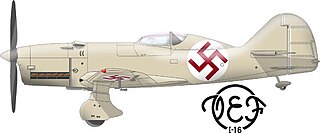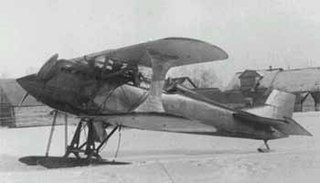
The VEF I-16 was a prototype Latvian fighter aircraft designed by Kārlis Irbītis and produced by VEF in 1939. Development was halted by the Soviet occupation of Latvia in 1940 and subsequent purges of VEF personnel.

The Yakovlev Yak-2 was a short-range Soviet light bomber/reconnaissance aircraft used during World War II. It was produced in small numbers, and most of them were destroyed during the opening stages of Operation Barbarossa.

The Grigorovich I-2 was a biplane fighter aircraft of the Soviet Union, the first indigenous fighter to enter service in substantial numbers. Developed from the Grigorovich I-1, it first flew on 4 November 1924, piloted by A.I. Zhukov. The M-5 engine was a Soviet copy of the Liberty L-12.

The DV.3 was a prototype fighter aircraft built and tested by AGO in 1915. It was a two-bay biplane of conventional configuration with a neatly cowled engine. Development was delayed by AGO's commitment to building reconnaissance aircraft, and when the DV.3 flew, its performance was found to be far lower than predicted and all further work was abandoned.

The Fiat CR.20 was an Italian biplane fighter used during the 1920s and 1930s. Designed by Celestino Rosatelli, it represented an intermediate step from the early biplane CR.1 and the later, successful series CR.30, CR.32 and CR.42.

The Halberstadt C.V was a German single-engined reconnaissance biplane of World War I, built by Halberstädter Flugzeugwerke. Derived from the Halberstadt C.III, with a more powerful supercharged 160 kW (220 hp) Benz Bz.IVü engine, it saw service only in the final months of the war. Cameras were mounted in the observer's cockpit floor.

The Letov Š-31 was a fighter aircraft produced in Czechoslovakia in the early 1930s in a number of variants. All of the aircraft had metal tubular framing and fabric covering with a metal engine cowling.
The Nikitin NV-2 was a single-seat sporting aircraft produced in the USSR from 1935.
The Zmaj R-1 was a twin-engined prototype bomber produced by Zmaj aircraft of the former Yugoslavia, designed in the 1930s. The aircraft remained a prototype due to a number of difficulties in testing.

The Cessna Citation Sovereign is an American business jet developed by Cessna, part of the Cessna Citation family. Announced at the 1998 NBAA convention, the Model 680 made its maiden flight in February 2002, certification was awarded on June 2, 2004, and deliveries began in late September. The Citation Excel fuselage was stretched and joined with an all-new, larger wing and more powerful Pratt & Whitney Canada PW306C engines for increased maximum takeoff weight and a 3,200 nmi (5,900 km) range. The improved Sovereign+ was announced at the October 2012 NBAA for a first flight in April 2013 and deliveries in December, with added winglets and an improved flight deck and engines.
The Tupolev Tu-121 was an unmanned aircraft, intended for use as a cruise missile, designed by Tupolev in the Soviet Union during the Cold War.

VEF I-17 was a Latvian trainer aircraft designed in 1939 by Kārlis Irbītis. The I-17 was test flown in early 1940 and almost immediately accepted by Latvian Air Force. It was produced by the VEF factory in Riga.

The Tupolev Tu-116 is a turboprop-powered long-range airliner designed by the Tupolev design bureau and built in the USSR.

The KOD-1 was an Estonian-designed Latvian trainer aircraft built by Liepājas Kara Ostas Darbnīcas. The KOD-1 was built from 1936 until 1938 and was used as a trainer by the Latvian Aeroclub and the Aizsargi home guard.
The Aichi Experimental Type 15-Ko Reconnaissance Seaplane (Mi-go) was a prototype reconnaissance seaplane built by Aichi in the mid-1920s.
The Aviatik D.VI was a German prototype single-seater fighter aircraft of the First World War, designed by Aviatik.

The Bréguet XI was a prototype French biplane bomber of the First World War.

The CANT Z.505 was a prototype trimotor transport floatplane built by CANT in the 1930s.
The IMAM Ro.26, sometimes called the Romeo Ro.26, was a single-engine biplane trainer aircraft produced by the Italian aeronautical company IMAM in the early 1930s. Only one example was built.
The Richard TOM-1 was a prototype torpedo-carrying floatplane that was designed in the Soviet Union in the early 1930s that was not accepted for production. It was a mid-wing monoplane, with twin engines, and twin floats. The empennage consisted of a single tail-plane and three vertical fins.













